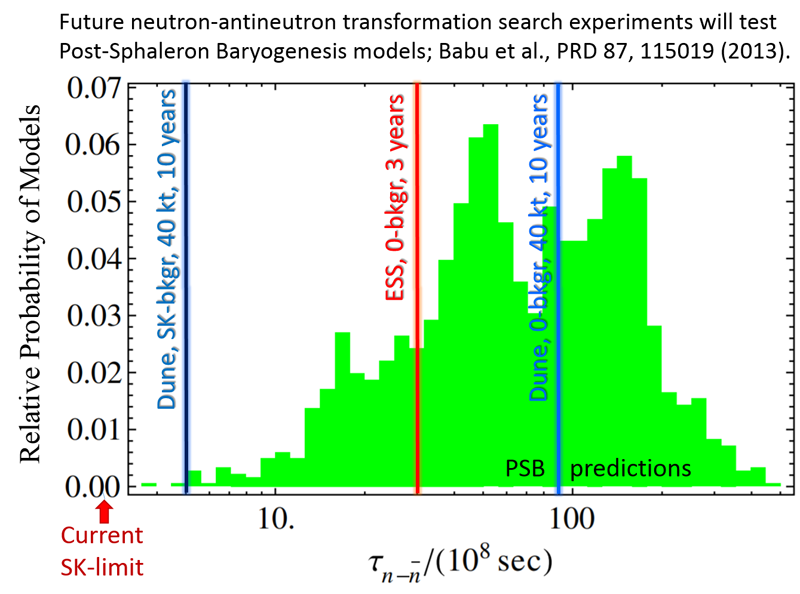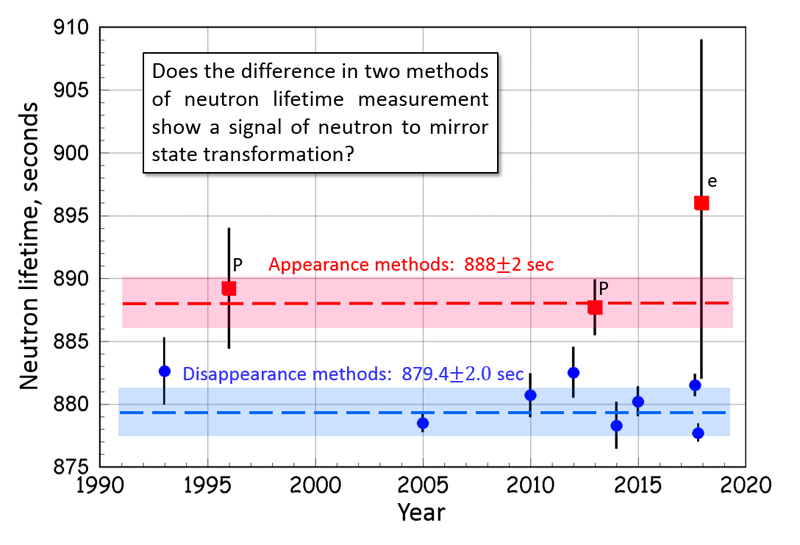Goal of workshop was the discussion of the current status of neutron oscillation phenomena between theory and experiment in relation with two outstanding questions of particle physics and cosmology: understanding of baryogenesis (mechanism of matter-antimatter asymmetry of universe) and understanding the nature of Dark Matter. Observable manifestations of the corresponding physics are the processes that can be seen in the new experiments with cold neutron beams and also with the large future underground detectors (DUNE, Hyper-K). These processes are neutron to antineutron transformation (n-nbar) and disappearance of neutrons to mirror-state neutrons (n-n') with possible regeneration of mirror sterile neutrons back to detectable neutrons.
During 5 days of workshop 36 participants delivered 40 presentations in 30-minute format with most of these focused on the workshop main topics. These presentations can be found at at this INT site. Besides the presentations there were about 10 hours of "organized discussions" sessions with 10 discussion topics proposed by the organizing committee. Ad-hoc section conveners were selected to represent controversial opinions with the initial discussion topics prepared in advance and when possible with slide illustration. In view of participants it was the most interesting part of the workshop. As was proposed by the organizing committee and agreed by participants the whole workshop group will create in a due time a common arXiv publication that will address most interesting and controversial questions discussed at the workshop.
Below we list most significant ideas and findings discussed at the workshop:
Post-Sphaleron Baryogenesis model is an example of theoretical model providing the range of n-nbar oscillation time observable in the future experiments at ESS and in DUNE.
Experimental observation of n-nbar transformations will be not only the first detection of the baryon number violation with ΔB=2, but will be a process playing a dominant role in the baryogenesis, making due to its lower energy scale all other possible higher energy scale mechanisms of baryogenesis obsolete.
Experimental observation of n-nbar is possible with free neutrons (e.g. at ESS facility in Europe, or at new dedicated facilities created at the research reactors including UCN facilities) and with bound neutrons (e.g. with large mass Ar detector DUNE). In both cases the significant increase of the sensitivity of detection of n-nbar effect will be possible if the detectors will demonstrate backgroundless conditions. That is the reason why collaborations with nuclear theorists are formed for the improvement of treatment of intranuclear processes, event generators, and nuclear suppression factors.
Status of discrete symmetries violations in n-nbar mixing P, T, C, and CP were discussed. The parity Pz2 = -1 in n-nbar is conserved by mass mixing term. Intranuclear transformations with ΔB=2 can be both CPz even and odd. Corresponding CPz odd six-quark operators can contribute to primordial baryogenesis.
Physics of processes with ΔB=2 can be different for free n-nbar and for intranuclear transformations. Search for both processes, if experimentally they will appear with not consistent probabilities, might reveal a new physics BSM.
N-nbar is a gold mine of information for theory on new physics BSM in multi-TeV range: e.g. new colored scalars, new B-violating forces, TeV scale origin of neutrino mass, possible connection to dark matter, violation of Lorentz invariance (connected to CPT violation), violation of Weak Equivalence Principle, and strength of long-range B-L forces.
The discrepancy between beam and trap (appearance and disappearance) methods of the neutron lifetime measurements is persistent with the new experimental data. This might be an indication that new BSM physics exist, perhaps related to neutron to mirror neutron transformation.
Model of Mirror Matter is a viable explanation of the nature of Dark Matter with consistent picture of cosmological evolution, co-baryogenesis of two components, formation of mirror stars and black holes, and contribution to cosmic ray physics near GZK cut-off.
One of the potentially observable effects of Mirror Matter is neutron transformation to mirror neutron that can be detected by variation of laboratory magnetic field in observation of several effects with slow neutrons (lifetime, asymmetry of UCN storage, disappearance, regeneration, spin rotation). Oscillation time n-n' in the range of tens of seconds for the magnetic fields ≲ 0.3 Gauss is not excluded by the previous experiments while for the larger magnetic fields it can be as small as one second. New searches are possible with cold neutron beams at HFIR, NIST, ILL; with UCN at PSI and WWR-M; and with high sensitivity at ESS. If disappearance effect will be found at non-zero magnetic field it will designate the existence of mirror photons and possible presence of mirror matter in the earth.
Direct detection experiments with lower target masses and lower thresholds will be important for identification of Mirror Dark Matter.
Possible seesaw mechanism of n-nbar and n-n' transformation might involve additional heavy fermions and color scalar di-quarks that in case of their low mass can show up in two-jet searches at LHC. This mechanism might connect the n-n' with small oscillation time as a primary process with n-nbar that can be the second order process with larger oscillation time.
Being inspired by particle theory and cosmology, the experimentalists are striving for more adequate funding of neutron oscillation experiments in Europe and in US.



